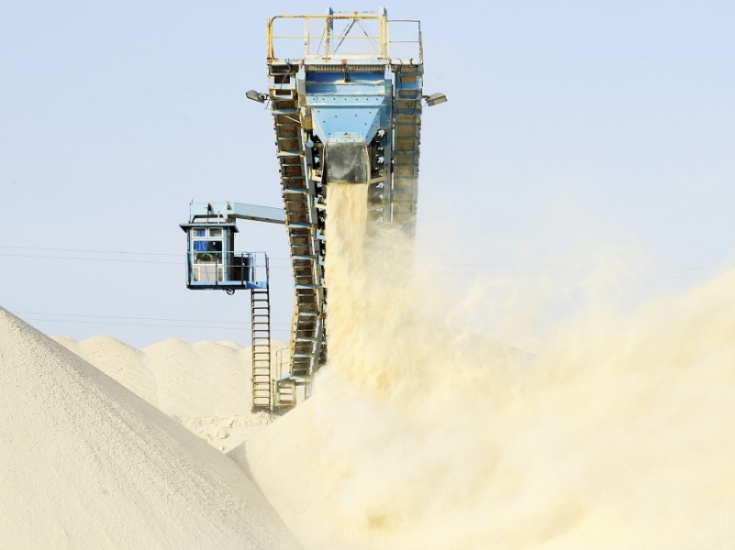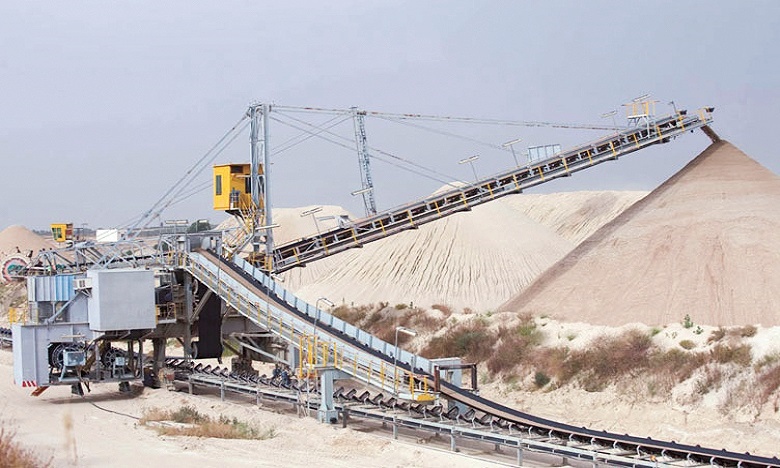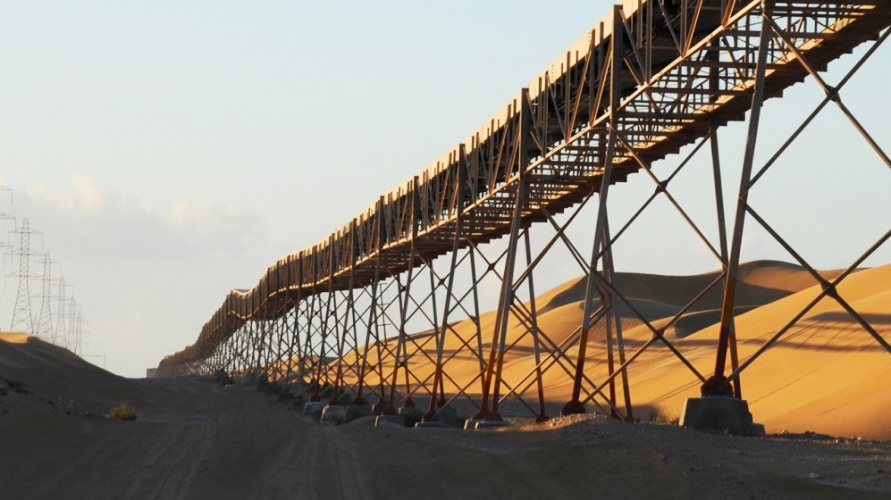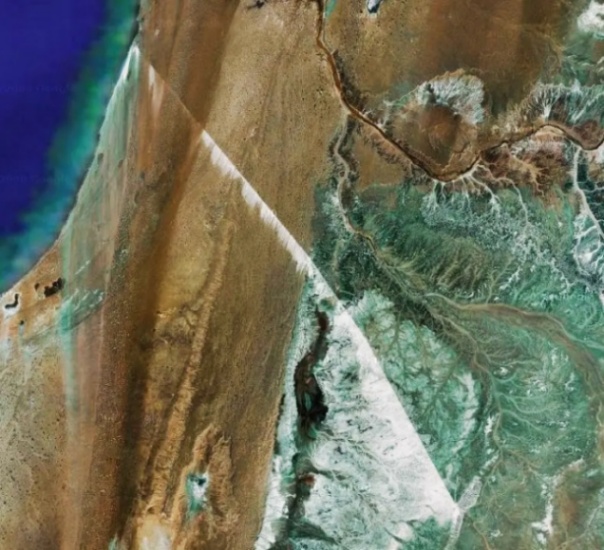World’s Longest Conveyor Belt: Morocco Phosphate Conveyor Belt
Morocco’s significant position in the global phosphate market cannot be overstated, with the nation standing as one of the world’s leading phosphate producers. Central to this prominence is the Morocco phosphate conveyor belt, an engineering marvel that stretches over 61 miles from the Bou Craa phosphate mine to the port town of Marsa near El Aaiún. This system not only epitomizes Morocco’s mining prowess but also represents the longest conveyor belt in the world, a testament to the country’s strategic investment in infrastructure to bolster its phosphate industry. The belt’s role in efficiently transporting phosphate ore across vast desert landscapes to global markets is a cornerstone of Morocco’s economic strategy, ensuring its status as a key player in the global supply chain of this critical agricultural and industrial resource.
The Significance of Phosphate and the Morocco Phosphate Conveyor Belt
Phosphate, a pivotal element in agriculture and industry, underpins the global food supply chain through its critical role in fertilizer production. As the backbone of modern agriculture, phosphate ensures the nourishment and growth of crops worldwide, making its availability and distribution key to food security. The significance of phosphate extends beyond agriculture into various industrial applications, including the manufacturing of detergents and the treatment of water, showcasing its versatility and indispensability.
Morocco’s ascendancy as a leading phosphate producer is anchored by its vast reserves, the largest globally, and the strategic deployment of the Morocco phosphate conveyor belt. This conveyor belt, stretching an impressive distance from the Bou Craa mine to the port for global distribution, is not just a feat of engineering but a lifeline for the global phosphate market. It ensures the steady flow of phosphate from the mines to international markets, where it is transformed into fertilizer and other essential products.
The Morocco Phosphate Conveyor Belt, transports phosphate from Bou Craa mines to Laayoune, crossing Western Sahara’s desert.The Morocco phosphate conveyor belt symbolizes Morocco’s commitment to leveraging its natural resources for economic development and global food security. By efficiently transporting phosphate ore across the challenging terrain of the Sahara, Morocco not only maximizes its export potential but also solidifies its position as a crucial supplier in the global phosphate industry. This conveyor belt system represents a significant logistical achievement, reducing transportation costs and environmental impact compared to traditional truck haulage methods.
Moreover, the strategic importance of phosphate for global agriculture cannot be overstated. As a key component of fertilizers, phosphate is essential for the production of crops needed to feed the world’s growing population. The role of the Morocco phosphate conveyor belt in facilitating the movement of this vital resource from one of the world’s largest phosphate reserves in Bou Craa to ports for global distribution is a testament to Morocco’s pivotal role in the global agricultural supply chain.
The Morocco phosphate conveyor belt is not just an engineering marvel; it is a critical component of the global phosphate industry, playing a vital role in agriculture and industry. Morocco’s position as a leading phosphate producer, supported by this extensive conveyor system, highlights the country’s strategic importance in ensuring global food security and industrial processes. The significance of phosphate, coupled with Morocco’s innovative approach to its transportation and distribution, underscores the interconnectedness of global industries and the essential nature of this mineral resource.
Bou Craa: Heart of Morocco Phosphate Conveyor Belt
The Bou Craa phosphate mine, nestled in the heart of the Western Sahara, is more than just a mining operation; it’s a cornerstone of Morocco’s economic and industrial prowess. Discovered in 1947 and commencing production in the 1970s, the mine’s development has been synonymous with Morocco’s ambitions on the global stage, particularly in the phosphate market. The mine’s vast reserves are considered among the largest in the world, contributing significantly to Morocco’s standing as a top phosphate producer.

The role of the Bou Craa mine extends beyond its economic contributions; it’s a symbol of Morocco’s strategic utilization of its natural resources. The mine’s output is transported via the Morocco phosphate conveyor belt, the longest of its kind globally, to the port of Marsa near El Aaiún. This logistical marvel not only showcases Morocco’s engineering capabilities but also its commitment to sustainable and efficient resource management. The conveyor belt’s operation minimizes the environmental impact typically associated with large-scale mining operations, offering a greener alternative to traditional transport methods.
Moreover, the Bou Craa mine and the conveyor belt system play a pivotal role in Morocco’s phosphate diplomacy. As the backbone of the country’s phosphate industry, the mine’s output is crucial for global agriculture, supplying phosphate to countries worldwide. This global supply chain positions Morocco as a key player in international markets, influencing global food security and agricultural productivity.
The development of the Bou Craa mine and the implementation of the Morocco phosphate conveyor belt system reflect Morocco’s broader economic strategies. By leveraging its natural resources, Morocco not only enhances its economic standing but also contributes to the global community, ensuring the continued availability of phosphate for agriculture and industry. The mine’s success story is a testament to Morocco’s vision and its role as a leader in the global phosphate industry.
Engineering Marvel: The World’s Longest Morocco Phosphate Conveyor Belt

The Morocco phosphate conveyor belt, an unparalleled feat of engineering, stretches over 61 miles (98 kilometers) from the heart of the Sahara Desert in Bou Craa to the port of El Aaiún. This makes it not only the longest conveyor belt in Africa but also the longest in the world, a title that underscores the ambitious scope of Morocco’s infrastructure capabilities. The belt’s design and construction are tailored to withstand the harsh desert conditions, showcasing innovative engineering that ensures reliability and efficiency in phosphate transport.
This conveyor belt surpasses other significant conveyor systems globally, including the longest overland conveyor in the world and notable systems within the United States and Oklahoma, in terms of length and operational challenges. Its construction involved overcoming considerable logistical hurdles, such as sandstorms and temperature extremes, demonstrating Morocco’s commitment to leveraging its phosphate reserves.
The significance of the Morocco phosphate conveyor belt extends beyond its physical dimensions. It represents a critical artery in the global phosphate supply chain, efficiently moving thousands of tons of phosphate ore daily. This continuous flow is essential for the global agriculture sector, as it ensures a steady supply of phosphate for fertilizer production, crucial for food production worldwide.
Comparatively, while other conveyor systems, such as the longest overland conveyor in the United States, serve significant logistical functions, the Morocco phosphate conveyor belt is unique in its combination of length, environmental challenges, and its role in international trade. Its existence not only highlights Morocco’s engineering prowess but also its strategic position in the global phosphate market.
The Morocco phosphate conveyor belt is more than just a transportation system; it’s a testament to human ingenuity and the drive to overcome natural barriers for economic and social advancement. Its role in facilitating the movement of a critical resource from one of the most remote regions on Earth to the global market cannot be overstated, marking it as a true marvel of modern engineering.
Morocco Phosphate Conveyor Belt: The Conveyor Belt System as a “Highway”
The Lifeline of Phosphate Transport
The term “conveyor belt highway” aptly describes the Morocco phosphate conveyor belt, highlighting its pivotal role in the seamless transport of phosphate ore. Spanning over 61 miles through the Sahara, this system functions as a vital lifeline, connecting the Bou Craa phosphate mine to the world. Its continuous operation ensures that phosphate, a key ingredient in global agriculture, reaches far-flung markets efficiently and reliably.
Overcoming Logistical Challenges

The logistics of moving phosphate ore over such a vast distance are complex. The Morocco phosphate conveyor belt overcomes these challenges through advanced engineering and meticulous maintenance. It navigates the harsh desert terrain, where extreme temperatures and sandstorms are common, showcasing Morocco’s innovative approach to resource transportation. This system not only exemplifies logistical efficiency but also environmental consideration, reducing the carbon footprint compared to traditional truck transport.
A Model of Efficiency and Sustainability
The conveyor belt highway is a model of efficiency, moving thousands of tons of phosphate daily with minimal human intervention. Its design minimizes energy consumption and operational costs, making it a sustainable choice for large-scale mineral transport. This efficiency is crucial for maintaining the competitiveness of Morocco’s phosphate in the global market, ensuring that this essential resource remains affordable and accessible.
The Morocco phosphate conveyor belt stands as a testament to human ingenuity, transforming a natural resource into a global commodity. Its existence not only supports Morocco’s economy but also contributes significantly to global food security, making it an indispensable component of the modern world.

Morocco Phosphate Conveyor Belt: Environmental and Visual Impact
Navigating the Environmental Footprint
The Morocco phosphate conveyor belt, while an engineering marvel, also presents a unique case study in environmental management. Its route through the Sahara Desert raises important considerations about the ecological footprint of such a massive infrastructure project. The system is designed to minimize disturbance to the desert’s ecosystem, employing measures to reduce dust emissions and conserve energy. This approach underscores Morocco’s commitment to sustainable mining practices, balancing industrial activity with environmental stewardship.
A Spectacle from Space

One of the most striking aspects of the Morocco phosphate conveyor belt is its visibility from space. The vast white streak of phosphate dust, contrasted against the stark desert landscape, creates a visual marker so distinct that it has caught the attention of astronauts and satellite imagery. This phenomenon not only highlights the scale of the conveyor belt but also serves as a reminder of human ingenuity’s impact on the planet. It symbolizes the lengths to which societies will go to harness natural resources, while also prompting discussions on sustainability and environmental impact.
Addressing the Challenges

Maintaining such a long conveyor system in the harsh Sahara Desert comes with its set of challenges. Sand accumulation, temperature extremes, and mechanical wear and tear require constant vigilance and innovative solutions. The management of the Morocco phosphate conveyor belt involves regular maintenance and technological upgrades to ensure its efficiency and longevity. These efforts are crucial for mitigating environmental impacts and ensuring the conveyor’s operation aligns with global sustainability goals.
The environmental and visual impact of the Morocco phosphate conveyor belt is a testament to Morocco’s role in the global phosphate market and its efforts to implement responsible and sustainable mining practices. The system not only facilitates the economic exploitation of phosphate resources but also embodies the challenges and responsibilities of modern industrial activities in sensitive environments.
Morocco Phosphate Conveyor Belt: Cultural and Political Context
The “Useful Triangle” and Territorial Expansion
The Morocco phosphate conveyor belt is more than an industrial achievement; it’s a symbol of Morocco’s territorial and economic ambitions. Situated within the “useful triangle,” the Bou Craa mine and its conveyor system are at the heart of Morocco’s efforts to assert control over Western Sahara. This region’s rich phosphate deposits have made it a focal point of Moroccan expansionist policies since the late 1970s. Morocco’s control over this territory, including the entire coastline, underscores the strategic importance of phosphate mining to the nation’s economic and geopolitical strategies.
Impact on Local Communities and International Relations
The presence of the world’s longest conveyor belt has profound implications for local communities and Morocco’s relations with neighboring countries and the international community. While the system facilitates significant economic benefits through phosphate exports, it also raises questions about resource sovereignty, environmental justice, and the rights of indigenous populations. The conveyor belt, therefore, becomes a focal point for discussions on sustainable development, equitable resource distribution, and international law, reflecting the complex interplay between economic development and social responsibility.
Navigating Geopolitical Tensions
The Morocco phosphate conveyor belt operates within a context of ongoing geopolitical tensions over the status of Western Sahara. Morocco’s investment in the region, exemplified by the conveyor belt system, is part of its broader strategy to cement its claim over the disputed territory. This situation has implications for international trade, diplomacy, and the principle of self-determination, making the conveyor belt a subject of international scrutiny and debate. The system’s role in Morocco’s phosphate industry thus intersects with broader questions of international relations and regional stability.
The cultural and political context surrounding the Morocco phosphate conveyor belt highlights the complex relationship between natural resource management, territorial sovereignty, and international diplomacy. As Morocco continues to leverage its phosphate resources for economic growth, the conveyor belt remains a symbol of the nation’s ambitions and the challenges of navigating the demands of modern industrial development within a contested geopolitical landscape.
Future Prospects and Innovations of the Morocco Phosphate Conveyor Belt
Advancements in Conveyor Technology
The future of the Morocco phosphate conveyor belt is intrinsically linked to advancements in conveyor technology and sustainable mining practices. As the demand for phosphate continues to grow, driven by the global need for food production and industrial applications, there is a pressing need for innovations that enhance efficiency, reduce environmental impact, and ensure the longevity of the conveyor system. Emerging technologies in materials science, automation, and energy efficiency promise to revolutionize how the conveyor belt operates, potentially setting new standards for the mining industry worldwide.
Sustainability and Environmental Stewardship
Looking ahead, Morocco’s phosphate industry, symbolized by the iconic conveyor belt, faces the challenge of balancing economic growth with environmental sustainability. The adoption of green technologies and practices, such as solar power to run conveyor operations and advanced dust suppression techniques, could mitigate the environmental footprint of phosphate mining. These initiatives would not only enhance the sustainability of the conveyor belt system but also reinforce Morocco’s position as a leader in responsible phosphate production.
The Global Market and Morocco’s Role
The future impact of the Morocco phosphate conveyor belt on the global market is significant. As the largest phosphate mine in the world continues to supply a critical resource, Morocco’s strategic investments in conveyor technology and infrastructure will play a pivotal role in shaping global phosphate supply chains. Moreover, Morocco’s efforts to innovate and sustainably manage its phosphate resources will likely influence global practices in mining and resource management, underscoring the country’s leadership in the sector.
Embracing Innovation for Global Leadership
The Morocco phosphate conveyor belt stands at the crossroads of tradition and innovation. As Morocco looks to the future, the potential for leveraging cutting-edge technology and sustainable practices offers a roadmap for not only enhancing the efficiency and environmental compatibility of the conveyor system but also for asserting global leadership in phosphate production. The continued evolution of this engineering marvel will be closely watched by industry observers and environmentalists alike, serving as a benchmark for the integration of industrial development with sustainability goals.
Enhance your conveyor system with our belts. Reach out for details.
FAQs about Morocco Phosphate Conveyor Belt
Morocco’s abundance of phosphate is largely due to its geological history. The region sits on the western part of the African Shield, which has experienced extensive geological activity over millions of years, leading to the formation of rich phosphate deposits. These deposits are part of the Phosphoria Formation, which dates back to the late Cretaceous to early Tertiary periods. Morocco, along with the Western Sahara, holds over 70% of the world’s phosphate reserves, making it the largest holder of phosphate in the world. The country’s vast phosphate resources are a result of natural sedimentary processes that have concentrated phosphate in this region over geological time scales.
The world’s longest conveyor belt is located in the Western Sahara, running through Morocco and the occupied territories. It stretches over 61 miles (98 kilometers) from the Bou Craa phosphate mines to the coastal city of El Marsa. This extraordinary conveyor belt system transports phosphate rock across the desert to the port for shipping to markets around the world. It is not only a critical component of Morocco’s phosphate industry but also an impressive feat of engineering, visible even from space.
The longest pipe conveyor in the world is the FlyingBelt Barroso Brasile in Brazil. It spans approximately 7.2 kilometers (about 4.5 miles) and connects a limestone quarry to a cement plant, offering an efficient and environmentally friendly means of material transport. The FlyingBelt stands out for its innovative design, combining the advantages of conveyor belts and aerial ropeways to minimize environmental impact and operational costs.
Phosphate mines in Morocco are primarily located in the region of Western Sahara, near the town of Bou Craa. Western Sahara is known for its extensive phosphate deposits, and the Bou Craa phosphate mine is one of the largest and most prominent phosphate mines in the world. Morocco and Western Sahara together hold a significant portion of the world’s phosphate rock reserves, making them major players in global phosphate production.
Last Updated on June 20, 2024 by Jordan Smith
Jordan Smith, a seasoned professional with over 20 years of experience in the conveyor system industry. Jordan’s expertise lies in providing comprehensive solutions for conveyor rollers, belts, and accessories, catering to a wide range of industrial needs. From initial design and configuration to installation and meticulous troubleshooting, Jordan is adept at handling all aspects of conveyor system management. Whether you’re looking to upgrade your production line with efficient conveyor belts, require custom conveyor rollers for specific operations, or need expert advice on selecting the right conveyor accessories for your facility, Jordan is your reliable consultant. For any inquiries or assistance with conveyor system optimization, Jordan is available to share his wealth of knowledge and experience. Feel free to reach out at any time for professional guidance on all matters related to conveyor rollers, belts, and accessories.





